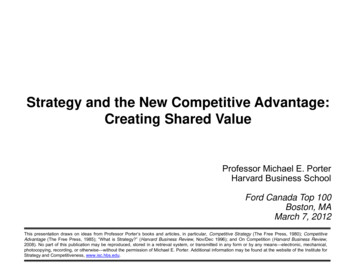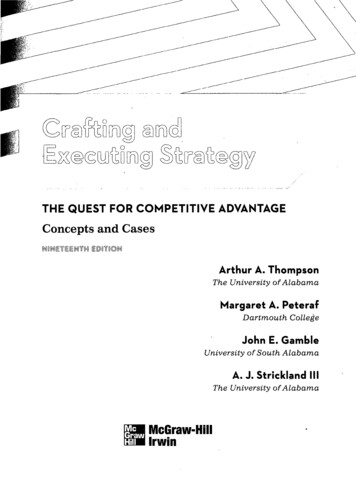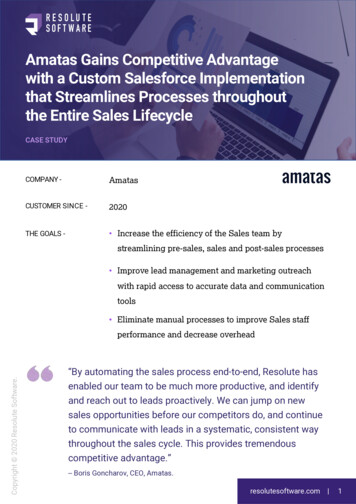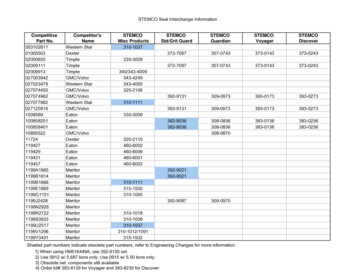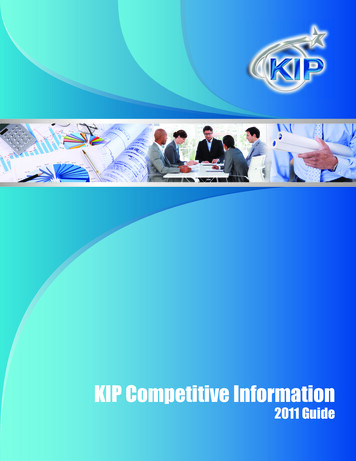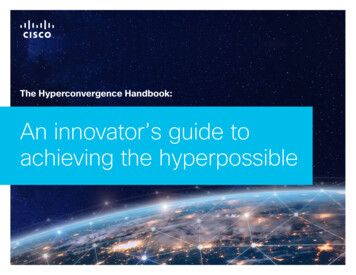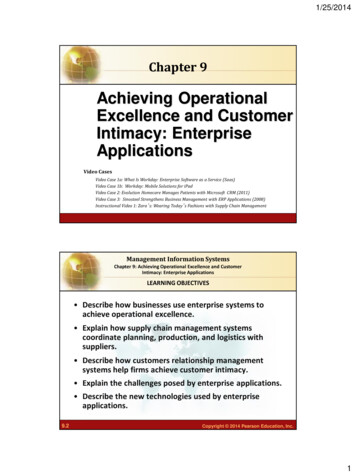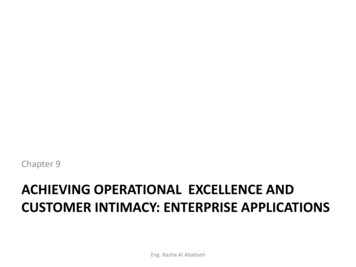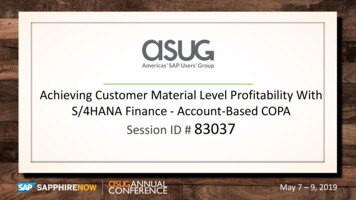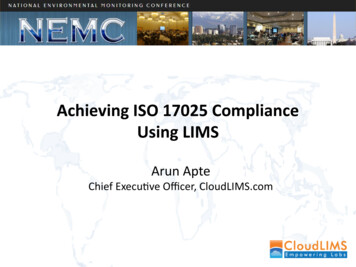
Transcription
Chapter 3Achieving CompetitiveAdvantage withInformation Systems3.1Copyright 2011 Pearson Education, Inc.
Essentials of Management Information SystemsChapter 3 Achieving Competitive Advantage with Information SystemsSTUDENT LEARNING OBJECTIVES How does Porter’s competitive forces model helpcompanies develop competitive strategies usinginformation systems? How do the value chain and value web modelshelp businesses identify opportunities forstrategic information system applications? How do information systems help businesses usesynergies, core competencies, and networkbased strategies to achieve competitiveadvantage?3.2Copyright 2011 Pearson Education, Inc.
Essentials of Management Information SystemsChapter 3 Achieving Competitive Advantage with Information SystemsSTUDENT LEARNING OBJECTIVES How do competing on a global scale andpromoting quality enhance competitiveadvantage? Evaluate the role of business processmanagement (BPM) in enhancingcompetitiveness.3.3Copyright 2011 Pearson Education, Inc.
Essentials of Management Information SystemsChapter 3 Achieving Competitive Advantage with Information SystemsVerizon or AT&T: Which Company Has the Best Digital Strategy? Problem Intense competition,difficult strategicdecisions. Solutions Verizon heavily promotesits FiOS service whereasAT&T partners withsmartphone developerslike Apple to strengthenits wireless business.3.4Copyright 2011 Pearson Education, Inc.
Essentials of Management Information SystemsChapter 3 Achieving Competitive Advantage with Information SystemsVerizon or AT&T: Which Company Has the Best Digital Strategy? Cutting-edge technologies like the iPhone and fiberoptic networks offer Verizon and AT&T opportunitiesto gain an edge. Illustrates digital technology’s role in gaining andmaintaining a competitive advantage And what about substitute providers like cablecompanies and Wi-Max (wide area Wi-Fi)?3.5Copyright 2011 Pearson Education, Inc.
Essentials of Management Information SystemsChapter 3 Achieving Competitive Advantage with Information SystemsVerizon or AT&T: Which Company Has the Best Digital Strategy?3.6Copyright 2011 Pearson Education, Inc.
Essentials of Management Information SystemsChapter 3 Achieving Competitive Advantage with Information SystemsUsing Information Systems to Achieve Competitive AdvantagePorter’s Competitive Forces Model One way to understand competitive advantage Five competitive forces shape fate of firm1. Traditional competitors Competitors in market space continuously devise newproducts, new efficiencies, switching costs.2. New market entrants 3.7Some industries have low barriers to entry: E.g., food industry versus microchip industryNewer companies may have advantages: Newer equipment, younger workforce, and so on.Copyright 2011 Pearson Education, Inc.
Essentials of Management Information SystemsChapter 3 Achieving Competitive Advantage with Information SystemsUsing Information Systems to Achieve Competitive AdvantagePorter’s Competitive Forces Model3. Substitute products and services Substitutes customers can purchase if your prices too high. E.g., Internet music service versus CDs.4. Customers Can customers easily switch to competitor’s products? Can customers force firm and competitors to compete onprice alone (transparent marketplace).5. Suppliers 3.8The more suppliers a firm has, the greater control it canexercise over suppliers.Copyright 2011 Pearson Education, Inc.
Essentials of Management Information SystemsChapter 3 Achieving Competitive Advantage with Information SystemsUsing Information Systems to Achieve Competitive AdvantagePorter’s Competitive Forces ModelIn Porter’scompetitive forcesmodel, the strategicposition of the firmand its strategiesare determined notonly by competitionwith its traditionaldirect competitorsbut also by fourforces in theindustry’senvironment: newmarket entrants,substitute products,customers, andsuppliers.3.9Figure 3-1Copyright 2011 Pearson Education, Inc.
Essentials of Management Information SystemsChapter 3 Achieving Competitive Advantage with Information SystemsUsing Information Systems to Achieve Competitive AdvantageInformation System Strategies for Dealing withCompetitive Forces Basic strategy: Align IT with business objectives 75 percent of businesses fail to align their IT with theirbusiness objectives, leading to lower profitability. To align IT: Identify business goals and strategies. Break strategic goals into concrete activities andprocesses. Identify metrics for measuring progress. Determine how IT can help achieve business goals. Measure actual performance.3.10Copyright 2011 Pearson Education, Inc.
Essentials of Management Information SystemsChapter 3 Achieving Competitive Advantage with Information SystemsUsing Information Systems to Achieve Competitive AdvantageInformation System Strategies for Dealing withCompetitive Forces Low-cost leadership Use information systems to achieve the lowest operationalcosts and the lowest prices. E.g. Wal-Mart Inventory replenishment system sends orders tosuppliers when purchase recorded at cash register. Minimizes inventory at warehouses, operating costs. Efficient customer response system.3.11Copyright 2011 Pearson Education, Inc.
Essentials of Management Information SystemsChapter 3 Achieving Competitive Advantage with Information SystemsUsing Information Systems to Achieve Competitive AdvantageSupermarkets and largeretail stores such as WalMart use sales data capturedat the checkout counter todetermine which items havesold and need to bereordered. Wal-Mart’scontinuous replenishmentsystem transmits orders torestock directly to itssuppliers. The systemenables Wal-Mart to keepcosts low while fine-tuningits merchandise to meetcustomer demands.3.12Copyright 2011 Pearson Education, Inc.
Essentials of Management Information SystemsChapter 3 Achieving Competitive Advantage with Information SystemsUsing Information Systems to Achieve Competitive AdvantageInformation System Strategies for Dealing withCompetitive Forces Product differentiation Use information systems to enable new products andservices, or greatly change the customer convenience inusing your existing products and services. E.g., Google’s continuous innovations, Apple’s iPhone. Use information systems to customize, personalize productsto fit specifications of individual consumers. Dell Mass customization at Lands’ End3.13Copyright 2011 Pearson Education, Inc.
Essentials of Management Information SystemsChapter 3 Achieving Competitive Advantage with Information SystemsUsing Information Systems to Achieve Competitive AdvantageInformation System Strategies for Dealing withCompetitive Forces Focus on market niche. Use information systems to enable specific market focus,and serve narrow target market better than competitors. Analyzes customer buying habits, preferences Advertising pitches to smaller and smaller targetmarkets E.g., Hilton Hotel’s OnQ System Analyzes data collected on guests to determinepreferences and guest’s profitability3.14Copyright 2011 Pearson Education, Inc.
Essentials of Management Information SystemsChapter 3 Achieving Competitive Advantage with Information SystemsUsing Information Systems to Achieve Competitive AdvantageInformation System Strategies for Dealing withCompetitive Forces Strengthen customer and supplier intimacy. Strong linkages to customers and suppliers increaseswitching costs and loyalty Toyota: uses IS to facilitate direct access from suppliers toproduction schedules Permits suppliers to decide how and when to ship suppliers toChrysler factories, allowing more lead time in producing goods. Amazon: keeps track of user preferences for purchases,and recommends titles purchased by others3.15Copyright 2011 Pearson Education, Inc.
Essentials of Management Information SystemsChapter 3 Achieving Competitive Advantage with Information SystemsUsing Information Systems to Achieve Competitive AdvantageInformation System Strategies for Dealing withCompetitive Forces Some companies pursue severalstrategies at same time. Dell emphasizes low cost pluscustomization of products. Successfully using IS to achievecompetitive advantage requires precisecoordination of technology, organizations,and people.3.16Copyright 2011 Pearson Education, Inc.
Essentials of Management Information SystemsChapter 3 Achieving Competitive Advantage with Information SystemsUsing Information Systems to Achieve Competitive AdvantageThe Internet’s Impact on Competitive Advantage Enables new products and services Transforms industries Increases bargaining power of customers andsuppliers Intensifies competitive rivalry Creates new opportunities for building brands andlarge customer bases3.17Copyright 2011 Pearson Education, Inc.
Essentials of Management Information SystemsChapter 3 Achieving Competitive Advantage with Information SystemsUsing Information Systems to Achieve Competitive AdvantageThe Internet’s Impact on Competitive Advantage Existing competitors: widens market, increasing competitors,reducing differences, pressure to compete on price New entrants: reduces barriers to entry (e.g., need for sales forcedeclines), provides technology for driving business processes Substitute products and services: facilitates creation of newproducts and services Customers’ bargaining power: bargaining power shifts tocustomer Suppliers’ bargaining power: procurement over Internet raisespower over suppliers, suppliers can benefit from reduced barriers toentry and elimination of intermediaries3.18Copyright 2011 Pearson Education, Inc.
Essentials of Management Information SystemsChapter 3 Achieving Competitive Advantage with Information SystemsUsing Information Systems to Achieve Competitive AdvantageThe Business Value Chain Model Highlights specific activities in a business wherecompetitive strategies can best be applied andwhere information systems are likely to have astrategic impact. Primary activities Support activities Benchmarking Best practices3.19Copyright 2011 Pearson Education, Inc.
Essentials of Management Information SystemsChapter 3 Achieving Competitive Advantage with Information SystemsUsing Information Systems to Achieve Competitive AdvantageThe Value Chain ModelThis figure providesexamples of systemsfor both primary andsupport activities of afirm and of its valuepartners that would adda margin of value to afirm’s products orservices.Figure 3-23.20Copyright 2011 Pearson Education, Inc.
Essentials of Management Information SystemsChapter 3 Achieving Competitive Advantage with Information SystemsUsing Information Systems to Achieve Competitive AdvantageExtending the Value Chain: The Value Web A firm’s value chain is linked to the value chains ofits suppliers, distributors, and customers. A value web is a collection of independent firmsthat use information technology to coordinate theirvalue chains to produce a product collectively. Value webs are flexible and adapt to changes insupply and demand.3.21Copyright 2011 Pearson Education, Inc.
Essentials of Management Information SystemsChapter 3 Achieving Competitive Advantage with Information SystemsUsing Information Systems to Achieve Competitive AdvantageThe Value WebThe value web is anetworked system thatcan synchronize thevalue chains ofbusiness partnerswithin an industry torespond rapidly tochanges in supply anddemand.Figure 3-33.22Copyright 2011 Pearson Education, Inc.
Essentials of Management Information SystemsChapter 3 Achieving Competitive Advantage with Information SystemsUsing Information Systems to Achieve Competitive AdvantageSynergies, Core Competencies, andNetwork-Based Strategies Synergies: When output of some units can be used as inputs toother units When two firms can pool markets and expertise (e.g.,recent bank mergers) Lower costs and generate profits Enabled by information systems that ties togetherdisparate units so they act as whole3.23Copyright 2011 Pearson Education, Inc.
Essentials of Management Information SystemsChapter 3 Achieving Competitive Advantage with Information SystemsUsing Information Systems to Achieve Competitive AdvantageSynergies, Core Competencies, andNetwork-Based Strategies Core competency: Activities for which firm is world-class leader. E.g., world’s best miniature parts designer, best packagedelivery service. Relies on knowledge that is gained over many years ofexperience as well as knowledge research. Any information system that encourages the sharing ofknowledge across business units enhances competency. 3.24E.g., Procter & Gamble uses intranet to help people workingon similar problems share ideas and expertise.Copyright 2011 Pearson Education, Inc.
Essentials of Management Information SystemsChapter 3 Achieving Competitive Advantage with Information SystemsUsing Information Systems to Achieve Competitive AdvantageSynergies, Core Competencies, andNetwork-Based Strategies Network-based strategies: Network economics: Marginal costs of adding another participant are nearzero, whereas marginal gain is much larger E.g., larger number of participants in Internet, greatervalue to all participants Virtual company: Uses networks to link people, resources, and ally withother companies to create and distribute products withouttraditional organizational boundaries or physical locations3.25Copyright 2011 Pearson Education, Inc.
Essentials of Management Information SystemsChapter 3 Achieving Competitive Advantage with Information SystemsUsing Information Systems to Achieve Competitive AdvantageDisruptive Technologies: Riding the Wave Disruptive technologies: Technologies with disruptive impact on industries andbusinesses, rendering existing products, services andbusiness models obsolete: Personal computers World Wide Web Internet music services First movers versus fast followers First movers of disruptive technologies may fail to seepotential, allowing second movers to reap rewards (fastfollowers)3.26Copyright 2011 Pearson Education, Inc.
Essentials of Management Information SystemsChapter 3 Achieving Competitive Advantage with Information SystemsCompeting on a Global ScaleThe Internet and Globalization Prior to the Internet, competing globally was onlyan option for huge firms able to afford factories,warehouses, and distribution centers abroad. The Internet drastically reduces costs of operatingglobally. Globalization benefits: Scale economies and resource cost reduction Higher utilization rates, fixed capital costs, and lower costper unit of production Speeding time to market3.27Copyright 2011 Pearson Education, Inc.
Essentials of Management Information SystemsChapter 3 Achieving Competitive Advantage with Information SystemsCompeting on a Global ScaleAn HP Laptop’s Path to MarketFigure 3-4Hewlett-Packard and other electronics companies assign distribution and productionof their products to a number of different countries.3.28Copyright 2011 Pearson Education, Inc.
Essentials of Management Information SystemsChapter 3 Achieving Competitive Advantage with Information SystemsCompeting on a Global ScaleGlobal Business and System Strategies Domestic exporters Heavy centralization of corporate activities in home country Multinationals Concentrates financial management at central home base whiledecentralizing production, sales, and marketing to othercountries Franchisers Product created, designed, financed, and initially produced inhome country but rely on foreign units for further production,marketing, and human resources Transnationals 3.29Regional (not national) headquarters and perhaps worldheadquarters; optimizing resources as neededCopyright 2011 Pearson Education, Inc.
Essentials of Management Information SystemsChapter 3 Achieving Competitive Advantage with Information SystemsCompeting on a Global ScaleGlobal System Configurations Centralized systems: All development and operation at domestic home base Duplicated systems: Development at home base but operations managed byautonomous units in foreign locations Decentralized systems: Each foreign unit designs own solutions and systems Networked systems: Development and operations occur in integrated andcoordinated fashion across all units3.30Copyright 2011 Pearson Education, Inc.
Essentials of Management Information SystemsChapter 3 Achieving Competitive Advantage with Information SystemsCompeting on a Global ScaleGlobal Business Organization Systems ConfigurationsThe large Xs show the dominant patterns, and the small Xs show the emerging patterns. Forinstance, domestic exporters rely predominantly on centralized systems, but there iscontinual pressure and some development of decentralized systems in local marketingregions.Figure 3-53.31Copyright 2011 Pearson Education, Inc.
Essentials of Management Information SystemsChapter 3 Achieving Competitive Advantage with Information SystemsCompeting on Quality and DesignWhat Is Quality? Producer perspective: Conformance to specifications and absence of variation fromspecs Customer perspective: Physical quality (reliability), quality of service, psychologicalquality Total quality management (TQM): Quality control is end in itself All people, functions responsible for quality Six sigma: Measure of quality: 3.4 defects/million opportunities3.32Copyright 2011 Pearson Education, Inc.
Essentials of Management Information SystemsChapter 3 Achieving Competitive Advantage with Information SystemsCompeting on Quality and DesignHow Information Systems Improve Quality Reduce cycle time and simplify productionprocess. Benchmarking Use customer demands to improve products andservices. Improve design quality and precision. Computer-aided design (CAD) systems Improve production precision and tightenproduction tolerances.3.33Copyright 2011 Pearson Education, Inc.
Essentials of Management Information SystemsChapter 3 Achieving Competitive Advantage with Information SystemsCompeting on Quality and DesignComputer-aideddesign (CAD) systemsimprove the qualityand precision ofproduct design byperforming much ofthe design and testingwork on the computer.3.34Copyright 2011 Pearson Education, Inc.
Essentials of Management Information SystemsChapter 3 Achieving Competitive Advantage with Information SystemsCompeting on Business Processes Businesses are collections of business processes—ways of working and getting things done. SeeChapter 1. Some times they are written in manuals, but in manycases business processes are informal. In order to use information systems effectively, youneed to change business processes. Before you can change processes, you need to changepeople’s attitudes and behaviors, and even theorganization itself.3.35Copyright 2011 Pearson Education, Inc.
Essentials of Management Information SystemsChapter 3 Achieving Competitive Advantage with Information SystemsCompeting on Business Processes Business process management continuousimprovement 3.36Identify processes for change.Analyze existing processes.Design new process.Implement new process.Measure new process.Copyright 2011 Pearson Education, Inc.
Essentials of Management Information SystemsChapter 3 Achieving Competitive Advantage with Information SystemsCompeting on Business ProcessesFigure 3-63.37Copyright 2011 Pearson Education, Inc.
Essentials of Management Information SystemsChapter 3 Achieving Competitive Advantage with Information SystemsCompeting on Business ProcessesFigure 3-73.38Copyright 2011 Pearson Education, Inc.
Essentials of Management Information SystemsChapter 3 Achieving Competitive Advantage with Information SystemsCompeting on Business ProcessesBusiness Process Reengineering A radical form of fast change Not continuous improvement, but elimination of oldp
Verizon or AT&T: Which Company Has the Best Digital Strategy? Cutting-edge technologies like the iPhone and fiber-optic networks offer Verizon and AT&T opportunities to gain an edge. Illustrates digital technology’s role in gaining and maintaining a competitive a
